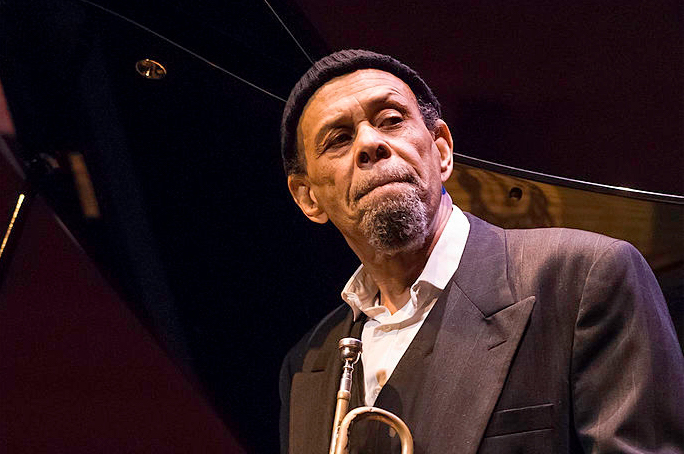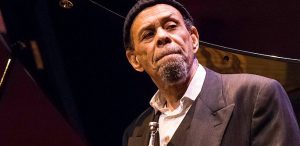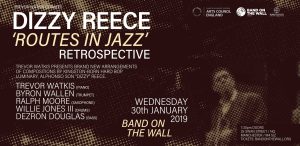“Struggle,” Dizzy Reece told Jazz Times journalist Christopher Porter in late 2003, describing the course of his then 50-year career. “That seems to be the theme of it.” Having left Jamaica in his teens, made a name for himself in Europe during his early twenties, and moved to New York in 1959, aged 28, Dizzy Reece’s early years were eventful to say the least. But the jazz trumpeter knew full well the difficulties that musicians in his position could face. He’d seen the darker side of New York’s jazz scene and it had seemingly impacted his family life. By 1962, his deal with Blue Note records had expired and into the mid-sixties, his first career rough patch would occur. However, being the inventive and determined creative he is, Reece would characterfully respond.
Pianist Trevor Watkis, who has built a strong relationship with Reece, is to present his ‘Routes in Jazz’ retrospective at Band on the Wall in January 2019. Featuring brand new arrangements of Dizzy Reece compositions, the show will honour Reece’s accomplishments and celebrate how the Kingston-born artist departed the Caribbean on the Windrush to pursue a career in Europe and later, the US. Ahead of the show, here’s the second part of our history on Dizzy Reece, a man described as ‘one of jazz’s best and most under-appreciated trumpeters.’
1962-1969: Peaks and troughs
During Reece’s time with Blue Note records, he had recorded — as so many of their roster did — with renowned engineer Rudy Van Gelder at his Englewood Cliffs studio. On his 1962 album for Prestige, Asia Minor, he did so again: inviting greats such as bassist Ron Carter (today, the most recorded jazz musician of all time,) renowned saxophonist Cecil Payne and pianist Hank Jones to record with him for the Spring session. It’s a beautifully recorded and sequenced album – the compositions reflecting Reece’s interest in the music of the Asian continent and regions of North Africa, with each piece transitioning nicely into the next. Though accomplished, Asia Minor would be the last session Reece would lead until 1967/68. The liner notes to the album perhaps suggest a reason why, Robert Levin writing:
‘Though he [Reece] is not an innovator, his problems have been similar to those which beset that special breed, for since Dizzy has his own way of playing the trumpet his talent is not so negotiable as the kind which would adhere to the currently conventional and the popularly sanctioned. And so he does not work, at least not with the frequency his talent warrants.’ In other words, Reece’s style, with its inherent idiosyncrasies, was not always desirable to bandleaders and always endearing to sidemen. When he wasn’t leading an ensemble, he was playing less frequently than more adaptable trumpeters on the scene.
Elsewhere in the liner notes to Asia Minor, Robert Levin suggest that Dizzy Reece was already working on numerous books and a screenplay. Writing, along with filmmaking and event organisation, would all factor into Dizzy’s extramusical activities in the ensuing years.
Shortly after Asia Minor’s release, Reece headed to Canada for a short while, playing some of the music from the record. He is said to have made a TV appearance in Toronto in the Summer of 1963 for Sixty Minutes With Spoon, although no evidence of the recording can be found online. While there, he played with saxophonists Pepper Adams and John Gilmore, the latter of whom would accompany him on a later album.
A great admirer of the music of Thelonious Monk, Reece was unfortunate upon his return to New York not to be involved in a concert paying tribute to the pianist’s work. He rehearsed for and was scheduled to appear at a big band collaboration with Monk and Hall Overton at New York’s Lincoln Centre, on November 29th, 1963. However, the fatal assassination of president John F. Kennedy resulted in the concert’s postponement. Dizzy was unable to make the rescheduled date, meaning that the man who had composed Variations on Monk in homage to the pianist, would miss the opportunity to share the stage with him.
From then occurs a period of public inactivity for Reece. We next hear from him in 1966 with the registration of his first instructional book on jazz theory: Contemporary Jazz Drum Suite. Its contents included ‘an endless flow of rhythmic variations for the contemporary percussionist’ and it was one of various educational texts Reece would author, alongside Basic Jazz Bass Rhythm And Blues and other titles.
The following year, Reece’s interest in film is said to have led him to create The Pressure Cooker By Night, a thirty minute film concerning the night time streets of Manhattan and Harlem. Again, this film cannot be located through online research, but one source suggests that Reece’s quartet have previously provided a live soundtrack to the film during performances.
Having committed his knowledge of jazz music conventions to text, the unconventional trumpeter finally found himself back on the bandstand in 1968, alongside a veritable jazz legend at that. With Dizzy Gillespie’s Reunion Big Band, Reece toured throughout Europe, soloing during Mantega – the final track of this 1968 performance in Copenhagen.
After his work with Dizzy Gillespie and the resultant album, the sessions suddenly came flooding back for Reece. That same year, he had led sessions for Nirvana, recording original material that was not released until 2006. In March, 1969, Reece was back in Copenhagen, this time performing with saxophonist Dexter Gordon and trombone player Slide Hampton. Come July, an unlikely return to the Blue Note fold was on the cards, with Reece appearing on Hank Mobley’s The Flip, recorded in July with legendary drummer Philly Joe Jones in the stool. Just a week later, he accompanied the drummer again for a concert recording at Pescara Jazz in Italy. Then in November, over two separate sessions with Rudy Van Gelder, the material for Andrew Hill’s Passing Ships was recorded, but again withheld until the turn of the century. By the end of the decade, the man was out of obscurity and back in demand; as busy as a jazz musician could hope to be!
1970-1979: European travels and a free NYC jazz festival
By the late sixties, Reece had worked his way back into the rotation in New York City. But as that was happening, several jazz musicians from the US were heading to record in Paris, escaping the “New York uptightness” as pianist Dave Burrell put it, to make progressive recordings with musicians from France and North Africa, following the Pan-African Festival that had taken place in Algiers. Reece wasn’t amongst the artists recording for BYG Actuel, but in October 1970, he did appear at the Festival de Créteil, performing with drummer Art Taylor, saxophonist John Gilmore (who he had played with in Canada in ‘63) and French musicians Patrice Caratini on bass and Siegfried Kessler on piano. Recordings from the performance formed From In To Out, one of the first records released on the Paris-based Futura records, prior to Mal Waldron and Anthony Braxton also recording for the label.
After that, tracing Reece’s activities becomes even more challenging, but his discography tells us that he recorded in Prague with Slide Hampton & Václav Zahradník Big Band, in the Netherlands with Boy Edgar’s big band and created another explorative album under his own name, entitled Possession, Exorcism, Peace, before 1975. The latter contained a reimagining of the theme to The Exorcist, which is of course part of Mike Oldfield’s famous composition, Tubular Bells.
Between 1977 and ‘79, Reece made perhaps his most pertinent contributions to the history of jazz in New York. In April of 1977, he was involved in Clifford Jordan’s sessions for Inward Fire, taking place at NYC’s CI recording. The liner notes describe the session as a reunion of friends and Jordan and Reece’s relationship as one of old friends. Reece contributes two compositions to the record, including the suave closing track, Eat at Joe’s.
Then, in January 1978, Reece calls a session at NYC’s Blue Rock Studio to record Manhattan Project, accompanied by some of the musicians from Jordan’s Inward Fire session, including Jordan himself. Songs like Manhattan Walk and Yule on the Hudson make reference to the region where Dizzy worked and lived, while the imagery accompanying the album depicts a homely vibe to the sessions. The record which completed this NYC trilogy was Blowing Away, an album recorded with Ted Curson and an outstanding trio in June, 1978.
Following a December session with Art Matthews, Reece was ready to give New York City a jazz gift in 1979. Come October, the inaugural, Dizzy Reece-organised NYC Jazz Festival took place. Free entry performances were held at Damrosch park, within Citicorp and the Lincoln Centre – performers including Clifford Jordan, Charles Davis and Tommy Turrentine amongst others. The festival was short lived but resoundingly popular, paving the way for festivals that have occured since.
1980-2018: Below the radar, the archives bulge
‘It’s been mentioned that I’ve been under the radar for some time.’ Dizzy Reece told Jazz Inside magazine in 2014. ‘But while under the radar, I’ve been quite active.’
Reece’s activities of the last thirty-eight years have indeed been under the radar, deepening the mystery and intrigue surrounding the artist. He has recorded challenging solo trumpet works, kept archived numerous live recordings from the NYC jazz festival, written autobiographically, as well as penning articles and works including ‘a thick biographical history of jazz saxophonists,’ – but not necessarily thrusting those works onto the viewing public the second they are complete.
The past thirty-eight years have seen numerous recording released from his archive, but there are still many more unaccounted for, as his 2014 Facebook post suggests. Some of his live recordings from the eighties feature in Dermot Hussey’s Dizzy Reece radio hour, but otherwise his work from the era remains difficult to access.
One great document of the period though is the film, For Klook: The Story of the Paris Reunion Band. It captures the mid-eighties exploits of a band recalling the great Paris jazz scene of the sixties, while continuing their own relationship as musicians and to the music that had taken hold at least thirty years earlier. Reece can seen here soloing on various tracks.




